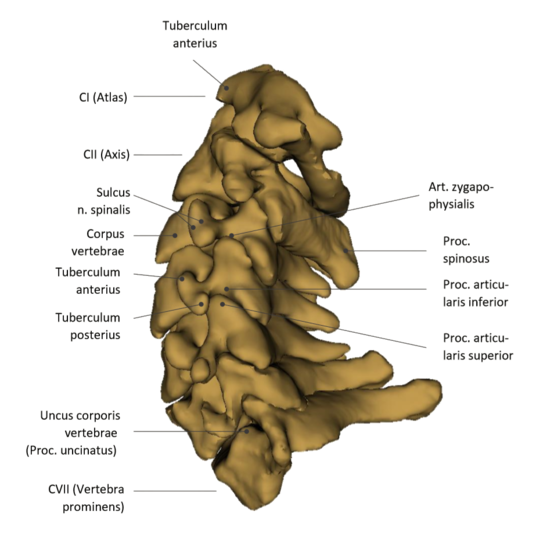Halswirbelsäule/en: Unterschied zwischen den Versionen
Becher (Diskussion | Beiträge) (Die Seite wurde neu angelegt: „Thus the atlantoaxial joint together with a narrow joint capsule allows a freedom of movement of 30° to the right and left.“) |
Becher (Diskussion | Beiträge) (Die Seite wurde neu angelegt: „The remaining '''five cervical vertebrae''' have a relatively small and almost cuboid vertebral body with a large triangular <i>foramen vertebrale</i>. <br> Th…“) |
||
| Zeile 10: | Zeile 10: | ||
Thus the atlantoaxial joint together with a narrow joint capsule allows a freedom of movement of 30° to the right and left. | Thus the atlantoaxial joint together with a narrow joint capsule allows a freedom of movement of 30° to the right and left. | ||
| − | + | The remaining '''five cervical vertebrae''' have a relatively small and almost cuboid vertebral body with a large triangular <i>foramen vertebrale</i>. <br> | |
| − | + | The edges are saddle-shaped and rise on the cranial surfaces (<i>Procc. uncinatus</i>), which, however, do not become visible until the age of 10. <br> | |
| − | + | The seventh cervical vertebra is called <i>Vertebra prominens</i> (protruding vertebra) because its spinous process protrudes a little further than the other six cervical vertebrae. Therefore, it also serves well as a point of orientation. | |
| − | |||
Durch die Querfortsätze der Halswirbelsäule verlaufen die Vertebralarterien (<i>Arteriae vertebrales</i>), sie stellen zusammen mit den inneren Halsschlagadern (<i>Arteriae carotidiae internae</i>) die Versorgung des Gehirns mit Blut sicher. | Durch die Querfortsätze der Halswirbelsäule verlaufen die Vertebralarterien (<i>Arteriae vertebrales</i>), sie stellen zusammen mit den inneren Halsschlagadern (<i>Arteriae carotidiae internae</i>) die Versorgung des Gehirns mit Blut sicher. | ||
Version vom 2. Januar 2020, 13:42 Uhr
The cervical spine forms the uppermost and most mobile part of thespine. It has seven cervical vertebrae. The 1st and 2nd cervical vertebrae (atlas and axis) clearly deviate from the basic form. The two cervical vertebrae together with the base of the skull form the upper and lower upper cervical joint (bicondylar joint).
The connection of the occipital bone with the first cervical vertebra is the atlantooccipital joint. This connection is surrounded by a loose joint capsule and is held in place by ligaments between the occiput and the anterior and posterior atlas arches. This results in a range of motion of the joint of about 20° (forwards and backwards).
The atlantoaxial joint consists of three separate joints:
- the first between the tooth (Dens) of the axis vertebra, the anterior arch of the first cervical vertebra and a ligament (Ligamentum cruciforme atlantis) in the atlas
- the second and third joints are located left and right between the joint surfaces of the first cervical vertebra and the axis vertebra
Thus the atlantoaxial joint together with a narrow joint capsule allows a freedom of movement of 30° to the right and left.
The remaining five cervical vertebrae have a relatively small and almost cuboid vertebral body with a large triangular foramen vertebrale.
The edges are saddle-shaped and rise on the cranial surfaces (Procc. uncinatus), which, however, do not become visible until the age of 10.
The seventh cervical vertebra is called Vertebra prominens (protruding vertebra) because its spinous process protrudes a little further than the other six cervical vertebrae. Therefore, it also serves well as a point of orientation.
Durch die Querfortsätze der Halswirbelsäule verlaufen die Vertebralarterien (Arteriae vertebrales), sie stellen zusammen mit den inneren Halsschlagadern (Arteriae carotidiae internae) die Versorgung des Gehirns mit Blut sicher.
Die Halswirbelsäule zum freien Explorieren
| mit Annotationen | ohne Annotationen |
<segmenter border="1">https://dornheim.cloud/index.php/apps/segmenter/embedding/view?identifier=HQBtIMtKntIU</segmenter>
weiterführende Links
